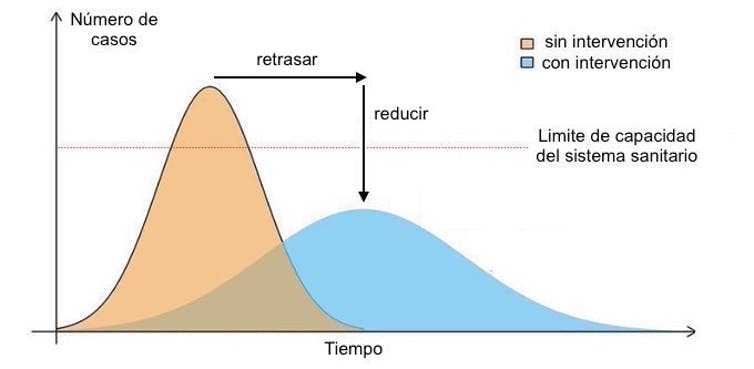Ignacio Lopez Goni, Full Professor of Microbiology. University of Navarra
We must stop the coronavirus curve: the vaccine is all of us
The WHO has declared that COVID19 is already a pandemic. Let us recall that this word means that there is sustained, effective and continuous transmission of the disease simultaneously in more than three different geographical regions. This is not synonymous with death: it does not refer reference letter to the lethality of a virus but to its transmissibility and geographical spread. No, we are not all going to die.
But why do the health authorities now insist so much on these containment and isolation measures and why are they so necessary?
In an epidemic of an infectious agent, the issue number of cases increases progressively over time. To understand how an epidemic spreads in a population, three types of individuals must be considered: those who may become infected, those who are already infected, and those who have recovered and are no longer susceptible to disease.
At the beginning the issue of susceptibles is high and the issue of infected people increases rapidly. As time goes by, the issue of susceptibles decreases (because they have been cured, immunized, vaccinated or died). There are fewer people to infect and we reach the peak of the epidemic. This is what is called the density limit: the issue minimum number of individuals necessary to continue the disease. Once reached, the pathogen can no longer be transmitted so effectively in the population and the issue of cases decreases. This is what epidemic curves are like.

How fast the epidemic goes and how sharp the curve is depends on many factors. Among others, the transmissibility of the virus and whether the population is more or less susceptible to infection. The problem with this SARS-CoV-2 coronavirus is that it is highly transmissible and, since it is new, the population has not had previous contact with it, they have no immunity and, in principle, we are all susceptible to getting sick.
It is very difficult to know where we are in the epidemic curve.
If the epidemic goes very fast and the curve is very sharp, one of the most serious problems is the collapse of the health system. It is not the same to have 10 cases in 10 days as 100 in a single day. Although 80% of cases of SARS-CoV-2 infection may be asymptomatic or mild, 16% may cause pneumonia and 4% may be fatal (provisional figures).
Pneumonias are not colds, they can be very serious and in many cases require hospitalization and even admission. That is the big problem, that the health system's capacity limit is exceeded and it collapses.
What remains above the capacity limit may be deaths.

That is why it is so important to stop the curve, the intervention measures. The goal is not that people do not become infected, this is probably already inevitable, but that the peak of the epidemic is delayed and reduced. For that, there are containment measures that are applied in the first days of the curve. This is when you have few and very localized outbreaks, you know how they have been infected, you can diagnose and isolate the infected person and follow up the people who have been to contact with that person and quarantine them.
Isolating the spotlights could slow down the curve.
But sometimes that is not enough and the issue of infected people increases. As I said, it is very difficult to know where we are in the epidemic curve. It is then when you must adopt more drastic measures, social quarantines, which must be as effective and sustainable over time and as least disruptive as possible.
What are those measures, what real benefit will each one have to curb the curve and what risk does it pose to the life of the citizen? That is a very difficult and complex decision. That is what the health authorities and governments, who are primarily responsible, are for.
Therefore, we are now in the phase of slowing down the curve. Maybe you are one of the 80% of healthy people who will be infected and will go through it more or less mildly. But your actions can contribute to slowing down the curve or to us exceeding the capacity of the system. We have to armor our hospitals and protect our healthcare workers. We have to protect the weakest, those most susceptible to illness and even death, not only from the virus but from the collapse of the healthcare system. Elderly people with previous pathologies are the most vulnerable.
That is why all these measures that are being announced are so important. They are difficult, uncomfortable, they will affect us economically, but they are necessary. The best thing for a virus is many people, very board and moving. The less we move and the more separated we are, the better.
10 basic tips to #BrakeTheCurve:
-
Don't panic, being alert is not an alarm.
-
Wash your hands frequently and use internship when sneezing and coughing.
-
Exercise social distancing: no kissing, hugging, handshaking. Look for alternatives.
-
Do not go to crowded places: cultural, sporting and entertainment events.
-
Avoid traveling if it is not absolutely necessary. Reduce your trips by public transportation.
-
If you can, reduce meetings and work from home.
-
If you have any symptoms, stay at home and use the telephones indicated for this purpose.
-
Do not go to the hospital unless absolutely necessary.
-
Take special care of and protect the most vulnerable people, those with previous pathologies and the elderly.
-
Above all stay calm, there is also good news about the coronavirus.
This will happen, but we have to manage to slow down the shock. Remember: the vaccine is you!
